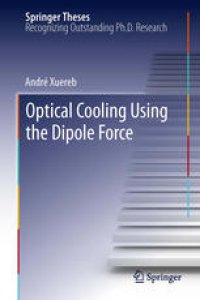
Ebook: Optical Cooling Using the Dipole Force
Author: André Xuereb (auth.)
- Tags: Atomic Molecular Optical and Plasma Physics, Laser Technology Photonics, Low Temperature Physics
- Series: Springer Theses
- Year: 2012
- Publisher: Springer-Verlag Berlin Heidelberg
- Edition: 1
- Language: English
- pdf
This thesis unifies the dissipative dynamics of an atom, particle or structure within an optical field that is influenced by the position of the atom, particle or structure itself. This allows the identification and exploration of the fundamental ‘mirror-mediated’ mechanisms of cavity-mediated cooling leading to the proposal of a range of new techniques based upon the same underlying principles. It also reveals powerful mechanisms for the enhancement of the radiation force cooling of micromechanical systems, using both active gain and the resonance of a cavity to which the cooled species are external. This work has implications for the cooling not only of weakly-scattering individual atoms, ions and molecules, but also for highly reflective optomechanical structures ranging from nanometre-scale cantilevers to the metre-sized mirrors of massive interferometers.
This thesis unifies the dissipative dynamics of an atom, particle or structure within an optical field that is influenced by the position of the atom, particle or structure itself. This allows the identification and exploration of the fundamental ‘mirror-mediated’ mechanisms of cavity-mediated cooling leading to the proposal of a range of new techniques based upon the same underlying principles. It also reveals powerful mechanisms for the enhancement of the radiation force cooling of micromechanical systems, using both active gain and the resonance of a cavity to which the cooled species are external. This work has implications for the cooling not only of weakly-scattering individual atoms, ions and molecules, but also for highly reflective optomechanical structures ranging from nanometre-scale cantilevers to the metre-sized mirrors of massive interferometers.
This thesis unifies the dissipative dynamics of an atom, particle or structure within an optical field that is influenced by the position of the atom, particle or structure itself. This allows the identification and exploration of the fundamental ‘mirror-mediated’ mechanisms of cavity-mediated cooling leading to the proposal of a range of new techniques based upon the same underlying principles. It also reveals powerful mechanisms for the enhancement of the radiation force cooling of micromechanical systems, using both active gain and the resonance of a cavity to which the cooled species are external. This work has implications for the cooling not only of weakly-scattering individual atoms, ions and molecules, but also for highly reflective optomechanical structures ranging from nanometre-scale cantilevers to the metre-sized mirrors of massive interferometers.
Content:
Front Matter....Pages i-xvi
Front Matter....Pages 7-7
Atom–Field Interactions....Pages 9-32
Trapping and Cooling Atoms....Pages 33-67
Front Matter....Pages 69-69
The transfer matrix model....Pages 71-113
Applications of Transfer Matrices....Pages 115-135
Three-Dimensional Scattering with an Optical Memory....Pages 137-141
Front Matter....Pages 143-143
Experimental setup....Pages 145-157
A Guide for Future Experiments....Pages 159-177
Conclusions and Outlook....Pages 179-181
Introduction....Pages 1-5
Back Matter....Pages 183-187
This thesis unifies the dissipative dynamics of an atom, particle or structure within an optical field that is influenced by the position of the atom, particle or structure itself. This allows the identification and exploration of the fundamental ‘mirror-mediated’ mechanisms of cavity-mediated cooling leading to the proposal of a range of new techniques based upon the same underlying principles. It also reveals powerful mechanisms for the enhancement of the radiation force cooling of micromechanical systems, using both active gain and the resonance of a cavity to which the cooled species are external. This work has implications for the cooling not only of weakly-scattering individual atoms, ions and molecules, but also for highly reflective optomechanical structures ranging from nanometre-scale cantilevers to the metre-sized mirrors of massive interferometers.
Content:
Front Matter....Pages i-xvi
Front Matter....Pages 7-7
Atom–Field Interactions....Pages 9-32
Trapping and Cooling Atoms....Pages 33-67
Front Matter....Pages 69-69
The transfer matrix model....Pages 71-113
Applications of Transfer Matrices....Pages 115-135
Three-Dimensional Scattering with an Optical Memory....Pages 137-141
Front Matter....Pages 143-143
Experimental setup....Pages 145-157
A Guide for Future Experiments....Pages 159-177
Conclusions and Outlook....Pages 179-181
Introduction....Pages 1-5
Back Matter....Pages 183-187
....